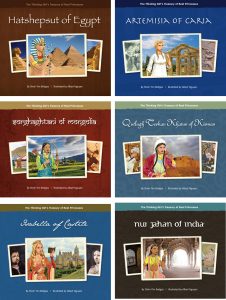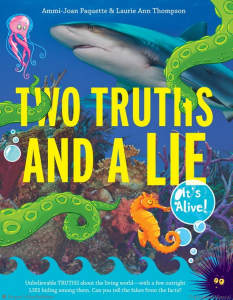Using Nonfiction in Book Clubs for Tweens
In recent years, there’s been a resurgence of interest in book clubs for grade school and middle school students. When librarians think of book clubs, many often imagine a traditional experience: selecting one work of fiction that a group of students has a set time to read, with everyone joining a discussion. When I started my first book club in 2015, however, I wanted to do something different. Many adult book clubs are branching out to meet the changing needs of the adult reading community, and I wanted to do the same thing for my younger readers. My goal was to include a wide range of readers, not only those who would be interested in reading and discussing the same book, which can default a book club to a very similar group of students at the same reading level and with the same interests. A traditional book club could also exclude readers who aren’t ready to tackle offerings with more mature themes or whose families have strict guidelines for reading choices.
I started my first book club with about five first through third graders who had a wide range of reading abilities. Two years later, I have two successful book clubs, one for first through third grades and one for third through fifth grades. I am also starting a third group for students in grades five and six. The grade requirements are fluid; I have welcomed kindergartners who read at a high grade level to my beginning book club as well as students with learning disabilities who felt more comfortable in the younger group. Kids in the crossover grades—third and fifth—can choose which club they feel most comfortable in.
I’ve monitored discussions about refugees, bullying, and historical events with students from vastly different backgrounds and belief systems. I’ve met the challenge of students who not only struggled to read but actively disliked reading; students with no attention span and attention issues; students who are voracious readers, many reading well above grade level; and “picky” readers. 
One of the secrets to my success is relying on a variety of titles in our book clubs, including expository and narrative nonfiction. For each book club, I handpick 10 or more selections, which encompass fantasy, realistic fiction, graphic novels, narrative nonfiction, and expository nonfiction. I also include reading levels ranging from easy readers to beginning chapters in my younger clubs and short, easy chapter books and nonfiction as well as more challenging titles in my older clubs.
Using nonfiction in book clubs has many advantages. Even in a medium-size consortium, I often have difficulty getting enough copies of a single title. Focusing on a nonfiction topic allows me to pick a range of titles from the same author or series and know they’re similar enough that kids won’t be upset if they don’t get the exact one they want. I always know I’ll have something available for my readers with strict parental controls; nonfiction, especially about animals and science, is almost always acceptable.
I’ve  also found expository nonfiction to be a big draw for reluctant and struggling readers and even for readers who don’t struggle but are bogged down with homework and extracurricular activities. Balancing expository nonfiction with narrative fiction and nonfiction ensures I’m meeting the interests and needs of all my readers, not just those who enjoy traditional fiction. When choosing titles, I look for several elements depending on my audience and what I’m trying to do in that particular book club session. I might be looking for a hook and a quick read, which I found in Nicola Davies’s “Animal Science” series. These trim books are hilariously illustrated with cartoons by Neal Layton and include titles such as Deadly! The Truth About the Most Dangerous Creatures on Earth, which lays out the hazard rating of creatures from tigers and sharks to tiny bugs. It’s not just a compendium of interesting facts, though; Davies brings together a collection of intriguing facts, offering a thoughtful conclusion on how humans relate to “dangerous” animals and our impact on the environment. I always try to introduce diverse viewpoints to my readers. I want them to be critical readers—and thinkers—and to draw their own conclusions from the titles we read and discuss. For that reason, I often use the series “The Thinking Girl’s Treasury of Real Princesses,” written by Shirin Yim Bridges. These titles include both narrative and expository nonfiction. They not only introduce little-known,
also found expository nonfiction to be a big draw for reluctant and struggling readers and even for readers who don’t struggle but are bogged down with homework and extracurricular activities. Balancing expository nonfiction with narrative fiction and nonfiction ensures I’m meeting the interests and needs of all my readers, not just those who enjoy traditional fiction. When choosing titles, I look for several elements depending on my audience and what I’m trying to do in that particular book club session. I might be looking for a hook and a quick read, which I found in Nicola Davies’s “Animal Science” series. These trim books are hilariously illustrated with cartoons by Neal Layton and include titles such as Deadly! The Truth About the Most Dangerous Creatures on Earth, which lays out the hazard rating of creatures from tigers and sharks to tiny bugs. It’s not just a compendium of interesting facts, though; Davies brings together a collection of intriguing facts, offering a thoughtful conclusion on how humans relate to “dangerous” animals and our impact on the environment. I always try to introduce diverse viewpoints to my readers. I want them to be critical readers—and thinkers—and to draw their own conclusions from the titles we read and discuss. For that reason, I often use the series “The Thinking Girl’s Treasury of Real Princesses,” written by Shirin Yim Bridges. These titles include both narrative and expository nonfiction. They not only introduce little-known,  influential female figures from history (for example, Sorghaghtani of Mongolia) but also include information on the culture, food, clothing, and other details of the time and place. Discussion questions help readers think more deeply about how historical figures are remembered and realize that there are different perspectives on their stories. Finally, I look for books that are fun to read.Two Truths and a Lie: It’s Alive! by Ammi-Joan Paquette and Laurie Ann Thompson includes both expository and narrative nonfiction, has a great hook, will definitely spark conversation, and is incredibly engaging. The work is modeled after the classic icebreaker, and each chapter includes three nonfiction narratives. Readers must carefully read all three, ponder the facts presented, and then decide which story is false and which are true. Lucy for us moderators, the facts are in the back of the book, as is a treasury of sources. In addition to being attention-grabbing, it’s also a great stepping-off point to explore the diverse interests of your book club members.
influential female figures from history (for example, Sorghaghtani of Mongolia) but also include information on the culture, food, clothing, and other details of the time and place. Discussion questions help readers think more deeply about how historical figures are remembered and realize that there are different perspectives on their stories. Finally, I look for books that are fun to read.Two Truths and a Lie: It’s Alive! by Ammi-Joan Paquette and Laurie Ann Thompson includes both expository and narrative nonfiction, has a great hook, will definitely spark conversation, and is incredibly engaging. The work is modeled after the classic icebreaker, and each chapter includes three nonfiction narratives. Readers must carefully read all three, ponder the facts presented, and then decide which story is false and which are true. Lucy for us moderators, the facts are in the back of the book, as is a treasury of sources. In addition to being attention-grabbing, it’s also a great stepping-off point to explore the diverse interests of your book club members.
Works Mentioned Deadly! The Truth About the Most Dangerous Creatures on Earth by Nicola Davies and Neal Layton. 2013 (reprint). Candlewick. ISBN 9780763662318. “The Thinking Girl’s Treasury of Real Princesses” (series) by Shirin Yim Bridges. 2010. Goosebottom Books. Two Truths and a Lie: It’s Alive! by Ammi-Joan Paquette and Laurie Ann Thompson. 2017. Walden Pond. ISBN 9780062418791.
RELATED
The job outlook in 2030: Librarians will be in demand
The job outlook in 2030: Librarians will be in demand
ALREADY A SUBSCRIBER? LOG IN
We are currently offering this content for free. Sign up now to activate your personal profile, where you can save articles for future viewing






Add Comment :-
Comment Policy:
Comment should not be empty !!!
Susan Ballew
I host a weekly 5th grade girls book club and, Literazzi, and this fall chose my first non-fiction book, Wonder by Palacio. It was a huge success! The life of Augie Pullman facilitated discussion in a way fiction could not. We then saw the movie when it released. This was a game changer for our book club!Posted : Jan 18, 2018 05:39
Heather Tuck-Macalla
I love the idea of mixing up non-fiction into book clubs. I run a 4th to 6th grade book club as well as a middle school book club and although we usually use fictional titles I have had success with the "Who Was" series. Everyone did not read the same biography however they all enjoyed hearing about the most interesting facts of each person. It was a fun change of pace. I have also used the non-fiction title "The Candy Bomber" and tied it into a community service project of donating bags of candy to our local food bank during the holidays. In my library's middle school book club, we just had a member request to discuss a cookbook next time. I love that idea, and hope to try it out. Thanks for these suggestions!Posted : Jan 17, 2018 07:37